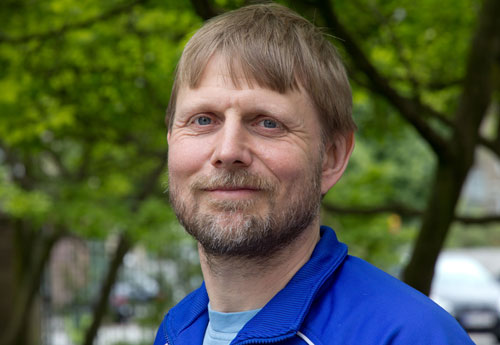X-ray and Neutron Science
Our research is centered around the use of large-scale experimental facilities using neutrons and X-rays, including the new X-ray source MAX-IV and the coming neutron source ESS, located in Lund (S), but also home-lab facilities e.g. via the CXC. With these sources, we study a wide range of hard and soft materials.
Our cross-disciplinary activities ranges from the study of polymer structure, over hydrogen dynamics in complex biophysical systems to the understanding of the complex quantum nature of magnets and superconductors.
Our activities are a combination of materials preparation, experimental studies with neutrons, X-rays and other techniques, numerical modeling and analytical theory. In addition, we contribute to the development of hardware and software to ESS and MAX-IV.
X-ray and Neutron Science is part of the section of Condensed Matter Physics with about 40 researchers, working closely to other sections at the Niels Bohr Institute, other institutes at the University of Copenhagen, X-ray and neutron facilities around the world, and a number of other international partners.
We have a common group meeting every 3-4 weeks. In addition, the individual groups in the section have their own weekly meetings.
Our group has a long and successful tradition for teaching and project supervision. We teach basic courses in Physics and Nanoscience, courses in Biophysics and Solid State Physics, and give three different M.Sc. courses and two PhD courses in X-ray and neutron techniques.
The average number of M.Sc. and B.Sc. students in the section is about 25, most being students of Physics or Nanoscience.
The Niels Bohr institute has many M.Sc. and PhD students. The students are closely attached to the research groups and supervisor, and have many social activities for International and Danish students.
If you are interested in studying Condensed Matter Physics, consider looking at these pages:
- M.Sc. in Physics, study track in experimental condensed matter physics, courses etc.
- M.Sc. in Physics, study track in theoretical condensed matter physics, courses etc.
General information about the education, application, living in Denmark etc.
Soft matter
We study the structure of soft matter, such as polymer materials and complex biophysical systems.
We study the polymers with a combination of scattering, rheology and numerical simulations, with particular emphasis on self-assembly and dynamics.
Considerable focus is also given to the study of hydrogen dynamics of specific polymers – mostly the ones applied in dentistry - as well as to the understanding of the dynamics of biologically bound water in living cells and proteins.
Magnetism and superconductivity
We study the role of magnetism in materials. In particular, we are interested in the connection between the magnetism and the functionality of materials.
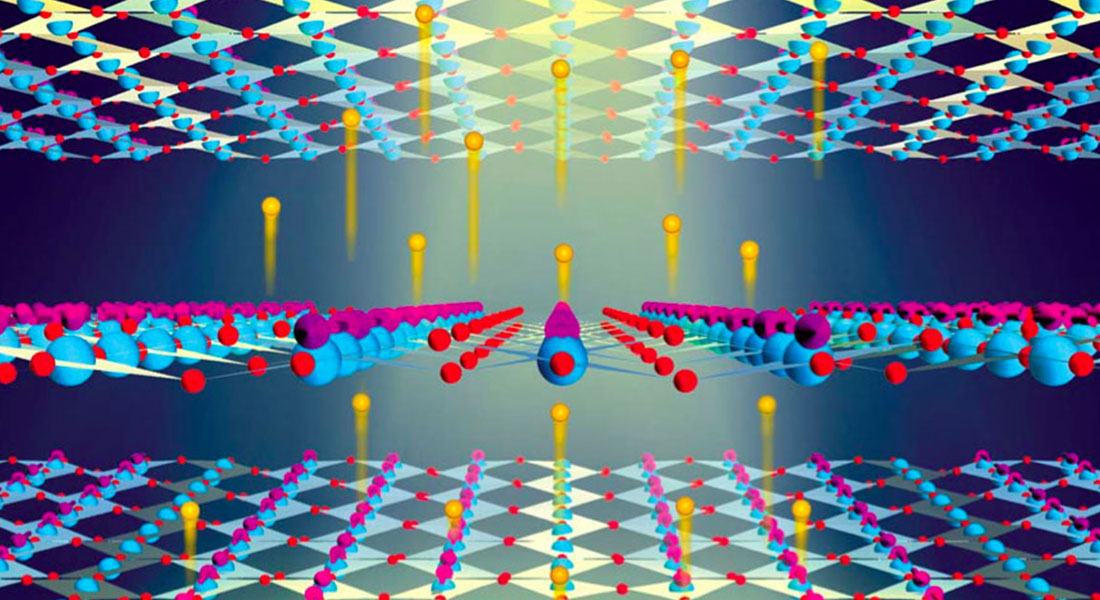
Examples of this are:
a) Unconventional superconductivity. We have a dedicated program to understand the role of magnetism in the high-temperature superconductors, with the ambition to understand the origin of superconductivity in these elusive materials.
b) “frustrated” magnets, where the energy landscape is very shallow and complicated, which in turn may lead to completely new states of matter;
c) many-body quantum mechanical correlation (entanglement) in magnets.
The X-ray and Neutron Science section has a range of in-house facilities for structural, solid-state and bio-physical studies. The section apply further to large extend international facilities for synchrotron X-ray and Neutron techniques, and has significant activities within new instrumental design and developement.
The in-house instruments are located within the H.C. Ørsted Institute, in laboratories for magnetism, for X-ray science and for biophysical studies and sample preparation. Several of the instruments are open to be used by external partners from universities as well as from industry. External application is done in terms of joint projecs.
The main instruments comprises:
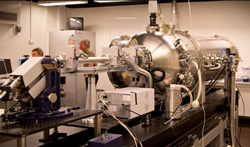 The company Biomodics have developed a patented technique to incorporate a hydrogel into silicone rubber, which is widely used for tubing in biomedicine, for example in urinary catheters used in hospitals. The advantage of Biomodics’s material is that the incorporation of hydrogel prevents the formation of biofilms (germs) and that the material potentially can be used for drug delivery. The LINX (Linking Industry to Neutrons and X-rays) group at NBI is involved in a project with the company in which their materials are studied with small-angle neutron and X-ray scattering (SANS and SAXS). For more information see here >>
The company Biomodics have developed a patented technique to incorporate a hydrogel into silicone rubber, which is widely used for tubing in biomedicine, for example in urinary catheters used in hospitals. The advantage of Biomodics’s material is that the incorporation of hydrogel prevents the formation of biofilms (germs) and that the material potentially can be used for drug delivery. The LINX (Linking Industry to Neutrons and X-rays) group at NBI is involved in a project with the company in which their materials are studied with small-angle neutron and X-ray scattering (SANS and SAXS). For more information see here >>Block copolymer self-assembly under hyperbolic confinement
Numerical simulations reveal a family of hierarchical and chiral multicontinuous network structures self-assembled from a melt blend of Y-shaped ABC and ABD three-miktoarm star terpolymers, se figure below. These mesostructures are among the most topologically complex morphologies identified to date and represent an example of hierarchical ordering within a hyperbolic pattern, a unique mode of soft matter self-assembly. In this project the idea is to implement a simulation setup to investigate the self-assembly of model block copolymers under different hyperbolic constraints, i.e. where the polymer are forced to assemble within a thin curved film. For more information see here >>
If you are interested - please contact Jacob Kirkensgaard (jjkk@nbi.ku.dk)
Simulation and experimental study of block copolymers self-assembling under spherical confinement
A rel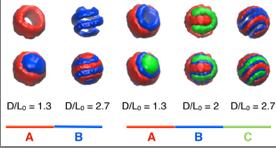 atively new, but conceptually simple experimental procedure makes it possible to form spherically confined nano-particles out of block copolymers by a clever evaporation of mixed good and bad solvent for the polymers. A new simulation setup allows to simulate such spherically confined systems of arbitrary mixtures of block copolymers which reproduce existing experimental results for diblock copolymers. In this project the idea is to investigate the effect of confinement on new metal containing diblocks and/or ABC star polymeric systems which in the melt state form many complex structures already. For more information see here >>
atively new, but conceptually simple experimental procedure makes it possible to form spherically confined nano-particles out of block copolymers by a clever evaporation of mixed good and bad solvent for the polymers. A new simulation setup allows to simulate such spherically confined systems of arbitrary mixtures of block copolymers which reproduce existing experimental results for diblock copolymers. In this project the idea is to investigate the effect of confinement on new metal containing diblocks and/or ABC star polymeric systems which in the melt state form many complex structures already. For more information see here >>
If you are interested - please contact Jacob Kirkensgaard (jjkk@nbi.ku.dk)
Block copolymer self-assembly under double spherical (shell) nano-confinement
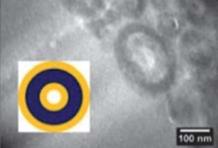 A relatively new, but conceptually simple experimental procedure makes it possible to form spherically confined nano-particles out of block copolymers by a clever evaporation of mixed good and bad solvent for the polymers. A new simulation setup allows to simulate such spherically confined systems of arbitrary mixtures of block copolymers which reproduce existing experimental results for diblock copolymers. In this project the idea is to investigate the effect of such confinement when the polymers at the same time are restricted to move on an inner sphere which could either be a metal nanoparticle or a liquid core. If this is a Master project there is a possibility to expand the project experimentally. For more information see here >>
A relatively new, but conceptually simple experimental procedure makes it possible to form spherically confined nano-particles out of block copolymers by a clever evaporation of mixed good and bad solvent for the polymers. A new simulation setup allows to simulate such spherically confined systems of arbitrary mixtures of block copolymers which reproduce existing experimental results for diblock copolymers. In this project the idea is to investigate the effect of such confinement when the polymers at the same time are restricted to move on an inner sphere which could either be a metal nanoparticle or a liquid core. If this is a Master project there is a possibility to expand the project experimentally. For more information see here >>
If you are interested - please contact Jacob Kirkensgaard (jjkk@nbi.ku.dk)
Structural characterization of thylakoid membrane stacks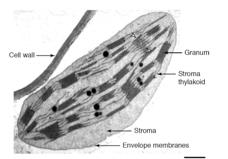 Thylakoid membranes (TM) are a vital part of the photosynthetic machinery in green plants, cyanobacteria and algae as most of the proteins taking part of the light capturing is embedded in this membrane system. TM’s has a very striking organization on mesoscales as they arrange into stacked cylindrical domains, ‘grana’, surrounded by membrane sheets,‘stroma lamellae’, connecting other grana. Ultimately we are interested in the role of this organization in the process of photosynthesis and specifically the structural behavior in the grana stack.
Thylakoid membranes (TM) are a vital part of the photosynthetic machinery in green plants, cyanobacteria and algae as most of the proteins taking part of the light capturing is embedded in this membrane system. TM’s has a very striking organization on mesoscales as they arrange into stacked cylindrical domains, ‘grana’, surrounded by membrane sheets,‘stroma lamellae’, connecting other grana. Ultimately we are interested in the role of this organization in the process of photosynthesis and specifically the structural behavior in the grana stack.
The project will be focused on structural characterization of well-defined TM’s cross-characterized by electron microscopy. This will be done performing detailed measurements using Small-Angle X-ray Scattering (SAXS). There are many possible directions for a project within this field - please come and discuss if interested. For more information see here >>
If you are interested - please contact Jacob Kirkensgaard (jjkk@nbi.ku.dk)
Wang-Landau Monte Carlo simulations of single ABC miktoarm star block copolymers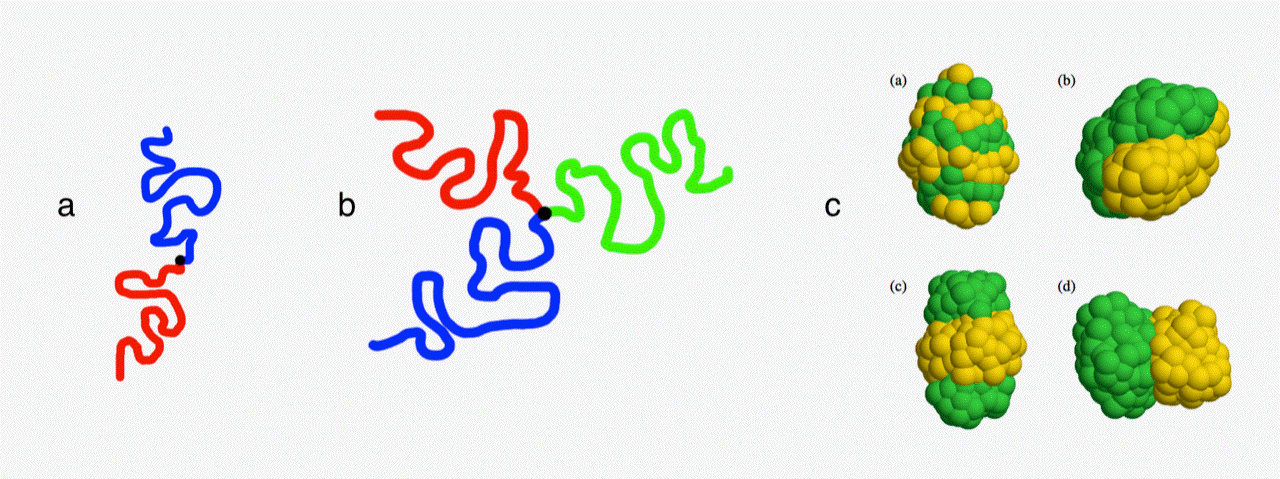 The behavior of single polymer chains under different solvent conditions plays a central role in polymer physics. This is also the case when different chains are combined to form block copolymers. A single homopolymer chain in a so-called bad solvent will collapse to a structureless compact globule minimizing unfavorable contact between the solvent and the monomers. Introducing two kinds of monomers A and B immediately gives rise to a much richer behavior. In particular, micro-phase separation is possible, leading to various interesting internal structures. In this project you will use a Wang-Landau Monte Carlo simulation setup to investigate 3-armed ABC star molecules. The major interest is how confinement within a globule, which in this case is a flexible kind of confinement, affects the resulting morphology. For more information see here
The behavior of single polymer chains under different solvent conditions plays a central role in polymer physics. This is also the case when different chains are combined to form block copolymers. A single homopolymer chain in a so-called bad solvent will collapse to a structureless compact globule minimizing unfavorable contact between the solvent and the monomers. Introducing two kinds of monomers A and B immediately gives rise to a much richer behavior. In particular, micro-phase separation is possible, leading to various interesting internal structures. In this project you will use a Wang-Landau Monte Carlo simulation setup to investigate 3-armed ABC star molecules. The major interest is how confinement within a globule, which in this case is a flexible kind of confinement, affects the resulting morphology. For more information see here
If you are interested - please contact Jacob Kirkensgaard (jjkk@nbi.ku.dk)
To view a researcher's publications, click on the link at the bottom of the page.
Kim Lefmann, professor
X-ray and Neutron Science
Universitetsparken 5,
HCØ, Building3, 2100 København Ø.
Email: lefmann@nbi.ku.dk
Phone: +45 29 25 04 76
Katrin Hjorth, Center Secretary
Niels Bohr Building
Jagtvej 128, 2. floor
2200 Copenhagen N.
Email: khjorth@nbi.ku.dk
Phone: +45 93 56 51 32
Staff
| Name | Title | Phone | |
|---|---|---|---|
| Search in Name | Search in Title | Search in Phone | |
| Als-Nielsen, Jens | Emeritus | +4528750425 | |
| Andersen, Brian Møller | Professor | ||
| Feidenhans'l, Robert Krarup | Visiting Professor | ||
| Joseph, Merin | Visitor | ||
| Kirkensgaard, Jacob Judas Kain | Associate Professor | ||
| Kreisel, Andreas | Assistant Professor | ||
| Krighaar, Kristine Marie Løfgren | PhD Student | +4535323770 | |
| Larsen, Andreas Haahr | Assistant Professor | +4535337646 | |
| Lefmann, Kim | Professor | ||
| Lenander, Emma Ynill | PhD Fellow | ||
| Mortensen, Kell | Professor Emeritus | +4535320464 | |
| Noerholm, Liv | Student FU | ||
| Nunes Bordallo, Heloisa | Associate Professor | +4535321215 | |
| Pedersen, Martin Cramer | External Research Assistant | +4535334852 | |
| Ray, Pia Jensen | Research Assistant | ||
| Schack, Silas Billeschou | Student | ||
| Theodor, Keld | Assistant Engineer | ||
| Tsekeridis, Charalampos | PhD Fellow | +4535321127 |

